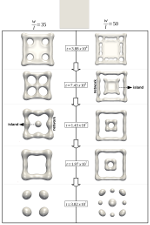
|
Motivation and objectives:
During induction hardening, a workpiece is momentarily heated up to austenitisation temperature. Hardened and tempered steel with a phase mixture of ferrite and cementite is the starting material for induction hardening. During heating, the carbides dissolve due to the diffusion of the carbon atoms, the structure of the iron lattice changes, and a homogeneous austenitic microstructure with an equally distributed carbon ratio is gradually formed. Thus, in order to understand the isothermal diffusional behaviour of carbon, the morphological of cementite which is entirely governed by volume-diffusion and curvature-difference is analysed using thermodynamically consistent phase-field model. |
|
